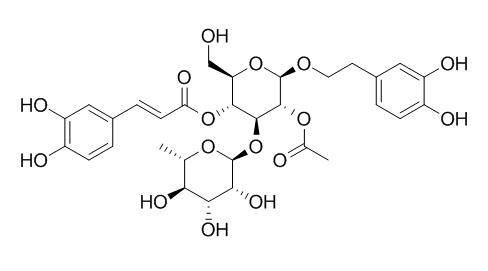2'-Acetylacteoside
2'-Acetylacteoside has antioxidative, hepatoprotective, and neuroprotective activities. 2'-Acetylacteoside (0.071 uM) demonstrates potent rat lens aldose reductase inhibitory activity; it can significantly suppress NADPH/CCl4-induced lipid peroxidation in rat liver microsomes.
Inquire / Order:
manager@chemfaces.com
Technical Inquiries:
service@chemfaces.com
Tel:
+86-27-84237783
Fax:
+86-27-84254680
Address:
1 Building, No. 83, CheCheng Rd., Wuhan Economic and Technological Development Zone, Wuhan, Hubei 430056, PRC
Providing storage is as stated on the product vial and the vial is kept tightly sealed, the product can be stored for up to
24 months(2-8C).
Wherever possible, you should prepare and use solutions on the same day. However, if you need to make up stock solutions in advance, we recommend that you store the solution as aliquots in tightly sealed vials at -20C. Generally, these will be useable for up to two weeks. Before use, and prior to opening the vial we recommend that you allow your product to equilibrate to room temperature for at least 1 hour.
Need more advice on solubility, usage and handling? Please email to: service@chemfaces.com
The packaging of the product may have turned upside down during transportation, resulting in the natural compounds adhering to the neck or cap of the vial. take the vial out of its packaging and gently shake to let the compounds fall to the bottom of the vial. for liquid products, centrifuge at 200-500 RPM to gather the liquid at the bottom of the vial. try to avoid loss or contamination during handling.
Plant Commun.2024, 5(10):101005.
Anticancer Res.2018, 38(4):2127-2135
J Food Compos Anal2017, 62:197-204
J Agric Food Chem.2021, 69(11):3496-3510.
Int J Mol Sci.2023, 24(15):12397.
J Ginseng Res.2022, 46(1):104-114.
Biochem Biophys Res Commun.2021, 534:802-807.
Agronomy2023, 13(9), 2410.
J Cell Mol Med.2023, 27(10):1423-1435.
Regen Biomater.2023, 10:rbad077.
Related and Featured Products
Planta Med. 1998 Mar;64(2):120-5.
Hepatoprotective activity of phenylethanoids from Cistanche deserticola.[Pubmed:
9525102 ]
METHODS AND RESULTS:
Four phenylethanoids isolated from the stems of Cistanche deserticola, acteoside (1), 2'-Acetylacteoside (2), isoacteoside (3) and tubuloside B (4), significantly suppressed NADPH/CCl4-induced lipid peroxidation in rat liver microsomes. Addition of them to primary cultured rat hepatocytes efficiently prevented cell damage induced by exposure to CCl4 or D-galactosamine (D-GalN).
CONCLUSIONS:
Acteoside (1) further showed pronounced anti-hepatotoxic activity against CCl4 in vivo.
Planta Med. 2005 Aug;71(8):778-80.
In vitro neuroprotective activities of phenylethanoid glycosides from Callicarpa dichotoma.[Pubmed:
16142646 ]
METHODS AND RESULTS:
Ten phenylethanoid glycosides, forsythoside B, acteoside, 2'-Acetylacteoside, poliumoside, brandioside, echinacoside, isoacteoside, cistanoside H and E-tubuloside E as well as a new compound, Z-tubuloside E, were isolated from the n-BuOH fraction of Callicarpa dichotoma Raeuschel (Verbenaceae) by bioactivity-guided fractionation using glutamate-injured primary cultures of rat cortical cells as a screening system.
CONCLUSIONS:
These phenylethanoid glycosides significantly attenuated glutamate-induced neurotoxicity at concentrations ranging from 0.1 to 10 microM.
J Nat Med. 2014 Jul;68(3):561-6.
Acylated phenylethanoid glycosides, echinacoside and acteoside from Cistanche tubulosa, improve glucose tolerance in mice.[Pubmed:
24748124]
METHODS AND RESULTS:
Acylated phenylethanoid glycosides, echinacoside (1) and acteoside (2), principal constituents in stems of Cistanche tubulosa (Orobanchaceae), inhibited the increase in postprandial blood glucose levels in starch-loaded mice at doses of 250-500 mg/kg p.o. These compounds (1 and 2) also significantly improved glucose tolerance in starch-loaded mice after 2 weeks of continuous administration at doses of 125 and/or 250 mg/kg/day p.o. without producing significant changes in body weight or food intake.
CONCLUSIONS:
In addition, several constituents from C. tubulosa, including 1 (IC50 = 3.1 μM), 2 (1.2 μM), isoacteoside (3, 4.6 μM), 2'-Acetylacteoside (4, 0.071 μM), tubulosides A (5, 8.8 μM) and B (9, 4.0 μM), syringalide A 3-O-α-L-rhamnopyranoside (10, 1.1 μM), campneoside I (13, 0.53 μM), and kankanoside J1 (14, 9.3 μM), demonstrated potent rat lens aldose reductase inhibitory activity. In particular, the potency of compound 4 was similar to that of epalrestat (0.072 μM), a clinical aldose reductase inhibitor.
Planta Med. 2001 Aug;67(6):520-2.
Purification of phenylethanoids from Brandisia hancei and the antiproliferative effects on aortic smooth muscle.[Pubmed:
11509971 ]
METHODS AND RESULTS:
The present study describes the isolation and purification of acteoside, 2'-Acetylacteoside, poliumoside and brandioside, four phenylethanoid glycosides from Brandisia hancei. We examined their effects on the proliferation of cultured A7r5 rat aortic smooth muscle cells. The proliferative response was measured from the [(3)H]-thymidine incorporation into DNA. All four glycosides suppressed the proliferative response in the presence of 2 % or 5 % fetal bovine serum in a concentration-dependent manner. The rank order of effectiveness for inhibition of cell proliferation was: brandioside > or = poliumoside > 2'-Acetylacteoside > or = acteoside. The acetyl group at position 2' of glucose does not seem necessary for the anti-proliferative effects of acteoside and 2'-Acetylacteoside, while the hydroxy groups of the aromatic rings appear to play a role.
CONCLUSIONS:
Inhibition of smooth muscle cell proliferation by phenylethanoids indicates that these compounds may have preventative effects on arteriosclerosis.
Zhong Yao Cai. 2009 Jul;32(7):1067-9.
Structure-activity relationships of phenylethanoid glycosides in plants of Cistanche salsa on antioxidative activity.[Pubmed:
19873735]
To study the structure-activity relationships of phenylethanoid glycosides in plants of Cistanche salsa on antioxidative activity.
METHODS AND RESULTS:
By the assay systems of DPPH*, the antioxidant activity of six phenylethanoid glycosides from plants of Cistanche salsa was determined to investigate the relationship between the antioxidant activities and phenylethanoid glycosides's structural characteristics. The antioxidative activity of phenylethanoid glycosides was variant with dose-dependent effect. The sequence of the strength of the antioxidative activity of the six components was shown to be 2'-Acetylacteoside > Acteoside > or = Tubuloside B > or = Isoacteoside > Echinacoside > Cistanoside A.
CONCLUSIONS:
The antioxidative activity of phenylethanoid glycosides is related to the number of phenolic hydroxyl, steric hindrance, 2-acetyl on the middle glucopyranose, and the location of phenolic hydroxyl. Additionally, it may be related to the alpha, beta-unsaturated ketone of phenl-2-propenoyl.



